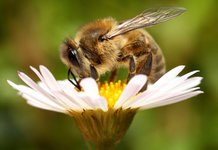
This is a question for which there is no exact answer. The figure can range from 15 to 200 kg.
Next I’ll talk about the factors that affect this.

Let's start with the strength of the family itself. Hthe stronger the family, the more it will bring honey. It would seem that if a strong family, for example, brought 100 kilograms of honey per season, then an average should bring 75, and, for example, a weak - 50.
But not everything is so simple with bees, and mathematics does not work here.
My practice has shown that one strong family is able to bring honey 5 or even 10 times more than any weak one.
The number of bees at different times of the year in the hive varies greatly. therefore beekeeper task a relatively weak family in the spring, disperse to the honey collection to maximum strength.

In addition to the strength of the family, there is two other factors that affect honey collection. This is the presence of honey plants and favorable weather during their flowering.
And if the beekeeper can still influence the first two factors, then with the weather it’s really lucky.
Bee vision many times better than humans, although the range of visible colors is very limited. For example, a bee sees blue, white, purple and yellow very well, but red and green does not see at all.
When looking at a flowering tree, a person sees green foliage more than flowers. A bee, on the contrary, sees only flowers and does not notice leaves at all.

It is naive to believe that all the beauty of the flora that surrounds us and these fragrances pleasant to our sense of smell were created by nature in the course of a long evolution, it is impossible for humans. All plants on the planet need to multiply, and for reproduction pollination is required. By their appearance and smell, plants attract pollinating insects, and bees occupy the first place.
The bee is a very old insect and developed with plants almost simultaneously. The plant attracts pollinator insects with its color and aroma.
Here once again I would like to draw an analogy with people. In the process of finding a partner, we carefully monitor our appearance. A man in every possible way tries to please a woman and vice versa. In order for pollination to occur qualitatively and evenly, plants bloom at different times, from early spring to late autumn.
Weak honey plants can bloom at the same time; strong honey plants such as linden or white acacia do not intersect in flowering, an interval of almost a month. If they bloomed at the same time, then pollination would not be so high-quality, and, accordingly, this would affect the reproduction of these crops. It’s easier with people in this regard)

A bee weighs a little over 100 mg.To bring nectar at a time, she is able to about half the mass of her body.
The farther the honey plant is from the hive, the less the bee will bring nectar. Indeed, for the flight she needs energy, and her bee receives from the same nectar. In other words, bee in flight continues to eat.
During copious nectar of excretion, a strong family can bring up to 16 kilograms per day, and even more. But there are very few such days in the year. It will be a shame if such a day falls on cloudy and rainy weather. Beekeepers even have a saying on this subject: “One day, a year feeds”.
Useful article? Then like it so I can understand how many of you are interested.


























